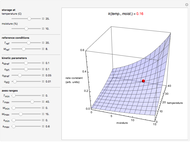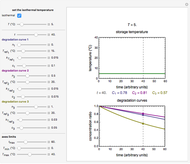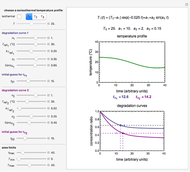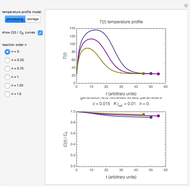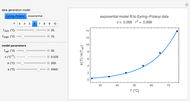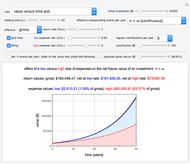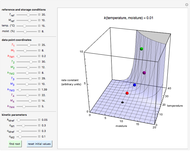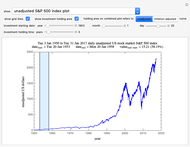Rate Constant Calculation from Four Temperature and Moisture Combinations

Requires a Wolfram Notebook System
Interact on desktop, mobile and cloud with the free Wolfram Player or other Wolfram Language products.
Experimental determination of the dependance of a reaction rate constant on both temperature and moisture is laborious and time consuming by conventional methods. This Demonstration describes a method to calculate the underlying kinetic parameters from a set of four experimental determinations, and thus estimate the rate constant at any temperature-moisture combination within a desired range. The mathematical model used is an exponential temperature-dependence model, a simpler substitute for the Arrhenius equation, in which the two-parameter moisture dependence is described by a similar two-parameter exponential model. The four parameters of the resulting rate constant-temperature-moisture relationship are extracted by numerically solving four simultaneous nonlinear equations with the built-in Mathematica FindRoot function. These extracted parameters are then used to plot a 3D surface depicting the rate constant-temperature-moisture relationship and to calculate and display the rate constant for any chosen temperature-moisture combination.
Contributed by: Mark D. Normand and Micha Peleg (August 2018)
Open content licensed under CC BY-NC-SA
Details
Snapshot 1: same control settings as the Thumbnail after parameter estimation with the FindRoot function
Snapshot 2: rate constant-temperature-moisture control settings that have no FindRoot solution
Snapshot 3: hypothetical control settings for high sensitivity to temperature and to moisture
Snapshot 4: hypothetical control settings for low sensitivity to temperature and to moisture
The rate of many deteriorative reactions in stored dry foods and pharmaceuticals depends on both their temperature and moisture content. However, calculating and mapping the rate constant-temperature-moisture relationship  by traditional methods requires the experimental determination of many degradation curves under constant temperature and moisture conditions, which can become a burdensome logistic issue when many different products are to be tested.
by traditional methods requires the experimental determination of many degradation curves under constant temperature and moisture conditions, which can become a burdensome logistic issue when many different products are to be tested.
A potential shortcut method is shown to estimate the  relationship from only four such curves, assuming that it can be characterized and mapped by an empirical four-parameter model in the pertinent temperature and moisture content ranges.
relationship from only four such curves, assuming that it can be characterized and mapped by an empirical four-parameter model in the pertinent temperature and moisture content ranges.
Assume that the relation can be described by the nested model
 ,
,
where
 and
and  are a chosen reference temperature in °C and moisture content on a dry or wet basis, respectively, and
are a chosen reference temperature in °C and moisture content on a dry or wet basis, respectively, and
 ,
,  ,
,  and
and  are the adjustable parameters [1].
are the adjustable parameters [1].
 ,
,
 ,
,
 ,
,
 ,
,
having four unknowns, which are the model parameters  ,
,  ,
,  and
and  .
.
These four simultaneous equations can be solved numerically using the FindRoot function to extract the four desired parameters. Once estimated, these parameter values together with the chosen values of  and
and  can be used to calculate and plot the
can be used to calculate and plot the  relationship and to estimate the rate constant's value at any chosen temperature-moisture combination within the relevant range.
relationship and to estimate the rate constant's value at any chosen temperature-moisture combination within the relevant range.
Use the sliders to set the experimental values of  ,
,  ,
,  and
and  , their corresponding temperatures and moisture content, and the selected
, their corresponding temperatures and moisture content, and the selected  and
and  . These are used to calculate and display the four model parameters and plot the
. These are used to calculate and display the four model parameters and plot the  relationship as a 3D surface.
relationship as a 3D surface.
When a solution is reached, the slider positions for  ,
,  ,
,  and
and  indicate their calculated values, which can be used as initial guesses in subsequent calculations.
indicate their calculated values, which can be used as initial guesses in subsequent calculations.
For each parameter setting, the program also calculates and displays the rate constant's magnitude for any chosen pair of  and
and  values that are entered with the bottom two sliders. Its position is shown as a movable black dot on the 3D
values that are entered with the bottom two sliders. Its position is shown as a movable black dot on the 3D  surface.
surface.
This Demonstration describes only the concept and mathematical methodology. The applicability of the model and methods to an actual reaction in a particular food or pharmaceutical product should be validated by testing its predictions against experimental observations not used in the kinetic parameters calculation.
Reference
[1] M. D. Normand and M. Peleg. "Reaction Rate Dependence on Temperature and Moisture During Storage" from the Wolfram Demonstrations Project—A Wolfram Web Resource. demonstrations.wolfram.com/ReactionRateDependenceOnTemperatureAndMoistureDuringStorage.
Snapshots
Permanent Citation






